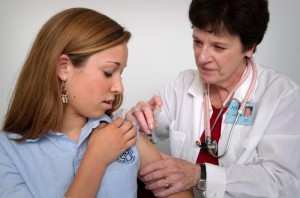study finds disappointing HPV vaccination rates – particularly in new south wales

Do you remember a few years back when the vaccination, Gardasil, was released? You probably do remember because (hopefully) you got the three free injections from your doctor as part of the Medicare scheme. I was slightly unlucky. I had my first two shots in America, and upon arriving in Australia, I did not yet have access to Medicare, so I had to pay $160 for the last vaccine.
Still, this was a worthy price to pay, as the vaccine has been developed to protect against the two high-risk HPV types, types 16 and 18, which cause 70% of cervical cancers in women and 90% of all HPV-related cancers in men. It also protects against two low-risk HPV types, types 6 and 11, which cause 90% of genital warts. Since the release of the vaccine, programs have been implemented to get the vaccine to young children and schools around Australia – for free, of course.
Since the implementation of the Gardasil program, over 97 million doses of the vaccine have been given safely, in over 120 countries around the world. According to the Australian Government Department of Health, the vaccine is now readily available as part of the national school-based HPV Vaccination program, in which it is free for males and females ages 12-13.
And according to a recent study, The Gardasil vaccine has reduced the frequency of abnormal Pap test results and precancers in women.
But just a few days ago, the National Health Performance Authority’s (HPA) Healthy Communities: Immunisation rates for children in 2012-13 report showed alarming rates of vaccination: of girls who turned 15 in 2012, only 70% of girls nationally had received all three doses of the HPV vaccine. Current guidelines recommend that all three doses are received in order to fully protect against the known cancer-causing types. The report also shows that some areas around the country show immunisation completion rates as low as 59%.
Byron Bay in New South Wales presented the most dangerous rates, with around a third of five year olds not up to date. New South Wales in general showed the most alarming rates, with the seven worst post codes including Manly, The Rocks and Parramatta.
The results speak loud and clear that Australia has the worst completion rates for the vaccine – strange considering it was Australia’s Professor Ian Frazer and his team at the University of Queensland who discovered how to make the vaccine particles, which form the basis of the HPV vaccine. But there is no denying that something is seriously wrong – there are, reportedly, some 60,000 children whose parents simply didn’t get around to making sure their children received all three doses.
Luckily, though, it is not all bad news. The Australian Medical Association president, Dr. Steve Hambleton, praised the improvement of the vaccine and the fact that it was getting to Indigenous Australians.
‘It’s fantastic. The community-controlled health services have gone out of their way to focus on immunisation,’ he said.
Nevertheless, there are major concerns about the results of the report.
CEO of the Australian Cervical Cancer Foundation (ACCF), Joe Tooma, said: ‘We now have statistical evidence to support previous estimations of the success rate of the vaccine, and we’re working hard to encourage Australians, both boys and girls, to participate in this life-saving vaccine,’ adding that Australians should avoid incurring significant personal expense by taking full advantage of the fact that it is available for free in schools. The ACCF runs a free program for Australian high schools called The Cervical Cancer Awareness Program for Schools (CCAPS), which aims to build awareness and education around HPV and cervical cancer prevention.
Interestingly, the results of the HPA report also show that there is no real divide in rural and city areas, so it really is up to the parents to make sure they stand up for their children’s health, and that schools continue to support the program. Even though I had to pay for my final vaccine, I wouldn’t have it any other way. It’s time Australia took advantage of this life-saving vaccine.


Pingback: Feminist News Round-Up: 05.04.14 | lip magazine